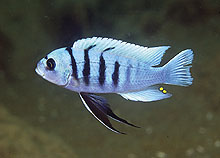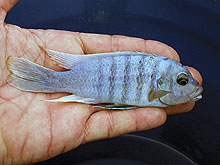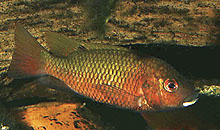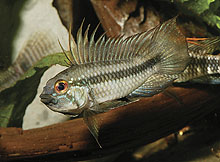WHAT'S NEW ACROSS THE WORLD
| What's New ©by
Laif DeMason
The seasons have changed and a cold winter’s wind
is blowing. People are modifying their outside activities for indoor entertainment.
Aquarists are re-thinking their fish set-ups and wondering if any changes
are needed. Cichlids hobbyists are re-visiting groups that had popularity
in the past as well as going outside the mainstream to select overlooked
varieties. A swing to West African riverine cichlids as well as Tanganyikan
shell dwellers is evident. Whether or not this trend to smaller cichlids
in smaller aquaria will persist remains to be seen.
Here’s “what’s new” on the cichlid scene: |
Lake Tanganyika
Collection and exports from the normal areas of Lake Tanganyika are
continuing per usual without interruption. Collection in infrequently visited
areas in Zambia and Tanzania are more regular as each exporter drives to
gain a little edge over competition. Areas in Congo are still visited sporadically,
with the usual talk of real fishing permits and permanent collecting bases
in the future.
|
what's new: Lake Tanganyika
|

Anyone for another blue Cyphotilapia frontosa?
This one from Fulwe Rocks, Tanzania, an infrequently visited collecting
site. Photo by A. Konings. |

Also from Fulwe Rocks, a Neolamprologus brichardi
variety sports blue facial markings. Photo by A. Konings. |

From the Kipili area (Tanzania), a recently exported
Callochromis macrops has orange facial markings and a jumbo size.
Photo by A. Konings. |

One of the originally exported Julidochromis species
from the early 1970s is the J. ornatus collected near Uvira (Congo). This
very yellow form was “lost” to the hobby but has been re-introduced by
select breeders. |
Lake Malawi
Supplies of collected and bred cichlids appear to be strong. Spotty
shortages in some juvenile bred items have been reported from Florida.
Collections in Tanzania and Malawi are good with fairly good supplies sent
from Mozambique as well. Certain “newly” discovered mbuna species are selling
better than expected showing signs of energized interest in this large
group.

Sold from Florida farms, an albino form of Aulonocara
sp. “Maleri sunshine”, often call “albino gold peacock”. |

Collected seasonally from the south in Tanzania, Lethrinops
sp. “Ntekete” is a colorful, jumbo form. |

Collected from Kande Island, Malawi, Aulonocara
sp. “steveni pale Usisya” is similar to the “flavescent Usisya” peacock
but with more blue in the body. Photo A. Konings. |

Collected in Magunga, Tanzania, this Protomelas
sp. “fire blue” has male coloration similar to the old fire blue “Ndiwe”
from the past. |

A new species collected from Gallireya Reef south
of Chilumba and sold as “blue afra” is really related to Metriaclima
zebra. Both male and female are blue and are of small size, reflected
by the “afra” label. Photo by A. Konings. |

On the opposite end of the Metriclima zebra scale,
this jumbo-sized “zebra chilumba” is from Maisoni Reef near Chitimba, Malawi. |
West Africa
Interest in Cameroon, Congo, Guinea, and Nigeria river cichlids has
increased. New varieties are being actively collected, like several river
Steatocranus from Congo and tilapiine types from isolated Cameroon lakes,
and are certainly new additions to aquarists’ collections. However, lasting
appeal for some species is unknown.

Collected and exported from Cameroon, Benitochromis
batesi is now more often available. |

A wide variety of Pelvicachromis taeniatus
types are exported. Here is the colorful P. taeniatus from Moliwe,
Cameroon. |

A new species from Lake Ejagham, Cameroon, Tilapia
deckerti is also called the “little black jewel” due to its breeding
dress. Photo by O. Lucanus. |

Another new species exported from Lake Bermin, Cameroon,
T. bythobates is a red variety. Photo by O. Lucanus. |
Neotropics
The collecting season was longer than usual in some parts of South America,
especially Brazil. Some other new material is collected and infrequently
exported from lesser-known countries in the Americas. Specialty breeders
often pick up on these items and reproduce them in numbers for other hobbyists.

Collected from the Rio Arua near Santaren, Brazil,
Apistogramma sp. “arua” is a newly offered variety. Photo by O.
Lucanus. |

Originally from the Rio Guarumo in Panama, Tomocichla
asfraci is a bright red form available from specialty breeders. Photo
by J. Rapps. |
|















